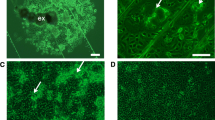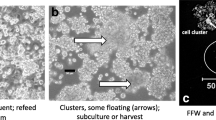Summary
Aedes albopictus mosquito cells resistant to the thymidine analog 5-bromodeoxyuridine (BrdU) were obtained using a single-step selection procedure. The resistant cells were characterized with respect to growth in the presence of BrdU, incorporation of [3H]uridine and [3H]thymidine, and thymidine kinase activity in crude extracts. The LC50 for TK-6 cells was 95µg BrdU/ml, and for TK-8 cells was 45µg/ml. Both clones incorporated [3H]uridine at levels corresponding to those in wild-type cells. TK-6 and TK-8 cells did not incorporate [3H]thymidine into acid-precipitable material, nor did they contain measurable thymidine kinase activity. Thymidine kinase activity in crude extracts from wild-type cells had a Km of 2µM and a Vmax of 10 pmol · min−1 · mg−1 protein.
Similar content being viewed by others
References
Abidi, T. F.; Plagemann, P. G. W.; Woffendin, C., et al. Nucleoside and nucleobase transport and metabolism in wild type and nucleoside transport-deficientAedes albopictus cells. Biochim. Biophys. Acta 897:431–444; 1987.
Dulbecco, R.; Vogt, M. Plaque formation and isolation of pure lines with poliomyelitis virus. J. Exp. Med. 99:167–182; 1954.
Eagle, H. Amino acid metabolism in mammalian cell cultures. Science 130:432–437; 1959.
Fallon, A. M. Factors affecting polybrene-mediated transfection of culturedAedes albopictus (mosquito) cells. Exp. Cell Res. 166:535–542; 1986.
Fallon, A. M.; Stollar, V. Isolation and characterization of cycloheximide-resistant mosquito cell clones. Mutat. Res. 96:201–212; 1982.
Fallon, A. M.; Stollar, V. Advances in cell culture. In: Maramorosch, K., ed. The biochemistry and genetics of mosquito cells in culture, vol. 5. New York: Academic Press; 1987:97–137.
Kwoh, T. J.; Engler, J. A. The nucleotide sequence of the chicken thymidine kinase gene and the relationship of its predicted polypeptide to that of the vaccinia virus thymidine kinase. Nucleic Acids Res. 12:3959–3971; 1984.
Lewis, J. A. Structure and expression of the Chinese hamster thymidine kinase gene. Mol. Cell. Biol. 6:1998–2010; 1986.
Lewis, J. A.; Shimizu, K.; Zipser, D. Isolation and preliminary characterization of the Chinese hamster thymidine kinase gene. Mol. Cell. Biol. 3:1815–1823; 1983.
Lin, P.-F.; Lieberman, H. B.; Yeh, D.-B., et al. Molecular cloning and structural analysis of murine thymidine kinase genomic and cDNA sequences. Mol. Cell. Biol. 5:3149–3156; 1985.
McBurney, M. W.; Whitmore, G. F. Mutants of Chinese hamster cells resistant to adenosine. Cell Physiol. 85:87–100; 1975.
McCarthy, W. J.; McKedy, D. Replication ofAutographa californica nuclear polyhedrosis virus in a thymidine kinase deficientSpodoptera exigua cell line (SE-UCR-IA). In Vitro Cell. Dev. Biol. 26:824–828; 1990.
Mento, S. J.; Stollar, V. Isolation and partial characterization of drugresistantAedes albopictus cells. Somat. Cell Genet. 4:179–191; 1978.
Nouri, N.; Fallon, A. M. Pleiotropic changes in cycloheximide-resistant insect cell clones. In Vitro Cell. Dev. Biol. 23:175–180; 1987.
Perucho, M.; Hanahan, D.; Lipsich, L., et al. Isolation of the chicken thymidine kinase gene by plasmid rescue. Nature 285:207–210; 1980.
Plagemann, P. G. W.; Wohlheuter, R. W. Permeation of nucleosides, nucleic acid bases, and nucleotides in animal cells. Curr. Top. Membr. Trans. 14:225–330; 1980.
Sarver, N.; Stollar, V. Sindbis virus-induced cytopathic effect in clones ofAedes albopictus (Singh) cells. Virology 80:390–400; 1977.
Sherwood, A.; Stollar, V.Aedes albopictus cells resistant to adenosine because of a defect in nucleoside transport. Somat. Cell. Genet. 8:575–585; 1982.
Singh, K. R. P. Cell cultures derived from larvae ofAedes albopictus (Skuse) andAedes aegypti (L.) Curr. Sci. 36:506–508; 1967.
Szybalska, E. H.; Szybalski, W. Genetics of human cell lines, IV. DNA-mediated heritable transformation of a biochemical trait. Proc. Natl. Acad. Sci. USA 48:2026–2034; 1962.
Wigler, M.; Silverstein, S.; Lee, L.-S., et al. Transfer of purified herpes virus thymidine kinase gene to cultured mouse cells. Cell 11:223–232; 1977.
Xie, W.; He, D.; Wang, X., et al. Lepidopteran cell variants resistant to 5-bromodeoxyuridine and their use for transfection of the HSV-TK gene. J. Cell Sci. 100:243–247; 1991.
Author information
Authors and Affiliations
Rights and permissions
About this article
Cite this article
Mazzacano, C.A., Fallon, A.M. Thymidine kinase-deficient mutants ofaedes albopictus mosquito cells. In Vitro Cell Dev Biol - Animal 28, 455–458 (1992). https://doi.org/10.1007/BF02634051
Received:
Accepted:
Issue Date:
DOI: https://doi.org/10.1007/BF02634051




